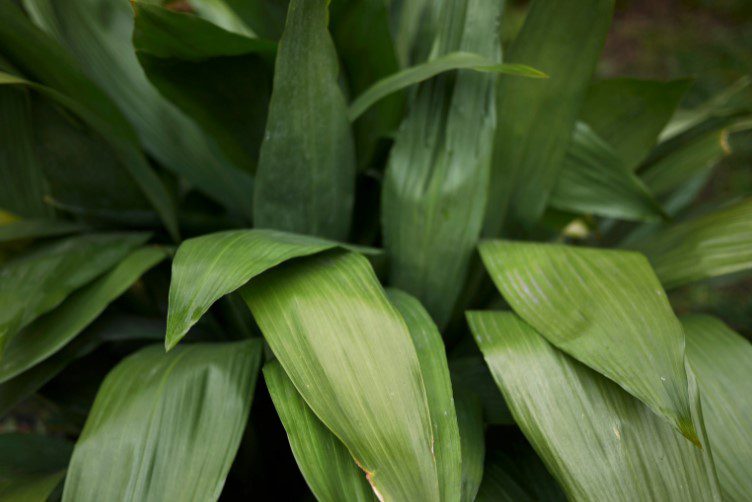Cast Iron Plant
Cast iron plants are able to withstand dust, poor conditions, and general neglect. You will need patience as it takes a long time to get an Aspidistra to the right size.
This tropical-looking plant is as hard as nails and will take everything you throw at it.
You can grow an aspidistra in any soil. However, it will thrive in rich, humusy potting soil. This soil should be kept moist and fertilized with a high-nitrogen fertilizer.
Balance light intensity and feeding for optimal growth of the 24-inch elliptical leaf.
Aspidistras can survive in dark corners, but they will thrive when placed near a window.
Aspidistras will thrive in brighter areas, but they will also be more able to eat more light.
While some plants can be fussy about the temperature, the aspidistra is not one of them. It is happy at a normal temperature in its home.
It can also be used as a groundcover in California and the South that receives light frosts.
Cast Iron Pests
Aspidistras indoors will not cause pest problems. You can put all your houseplants outside for the summer but make sure to keep the pot of aspidistra stocked with slug bait.
Aspidistras can be described as caviar for slugs or snails.
You can make your aspidistra bigger and better by potting it in larger pots, just like Gracie Field.
As the new leaves mature, trim the old ones. Instead of one large aspidistra, it is easier to divide the plant when it gets crowded. I keep my plants in 8-inch pots.
Although aspidistras can flower, you won’t notice the small brownish flowers at the soil level. An aspidistra’s leaf is the best thing.
Aspidistra, a dark-green Aspidistra elatior leaf, flows in a gentle curve. These leaves are a delight for florists and flower arrangers because of their natural grace and flexibility.
An aspidistra leaf can be wrapped around your hand to retain its original shape.
PROPAGATION
To divide your cast iron plant, make sure the new pot is substantial enough to support the leaves and has drainage holes in the bottom and some peat-free compost.
Slide your fingers between the stems to support the root ball, and carefully turn the plant on its side to remove the pot. Now carefully pry apart the plant into smaller clumps.
Aspidistras despise root disturbance, so divide as much as you dare to save you from having to do it again in the future, but keep in mind they are often slow to grow new leaves.
Repot the clumps at the same level before, also water well to settle the compost around the roots. The following spring, new leaves should unfurl from the base of the plant.
Ultimately, if your Aspidistra is not in full sun all day and you water it occasionally, you won’t kill it.
If you want it to thrive, there are a few things you can do to recreate its natural environment in your own home.
Endemic to the forest understory of Japan and Taiwan, Aspidistra enjoys filtered light, warm temperatures, and reasonably high humidity.
Your Aspidistra does need some light, although it can survive short periods of
Position away from a window, ideally in a kitchen or bathroom, rooms in the house that are typically more humid.
The cast iron plant, Aspidistra elatior, is an old favorite in southern landscapes. It is a clump-forming perennial plant that belongs to the Ruscaceae family.
The Cast-iron plant gets its name because it was a very common houseplant and was difficult to kill during Victorian times. It can tolerate a dark location, under watering, and neglect.
These same features make it an excellent perennial groundcover for shady spots.
Aspidistra elatior forms clumps 1 to 2 feet tall. It has dark-green, ovate leaves that grow on foot-long petioles.
The plant is grown for the foliage. Small, insignificant flowers are produced, but they are formed underground.
The cast-iron plant is straightforward to grow. It likes partial shade to full shade and can even tolerate very low-light locations in a landscape.
It also is very drought tolerant and, once established, needs little care. It transplants easily and is propagated by the division of clumps.
Cast Iron Plant Specs
Botanical name: Aspidistra elatior
Common name: Cast iron plant
Origin: Southern China
Growth Habit: Upright, evergreen perennial that forms clump 1 to 2 feet tall
Aesthetics/Characteristics: Darkgreen leaves 12 to 18 inches long; grows from underground rhizomes and produces a small, purple flower underground
Hardiness: Zones 8-11
Interiorscape/Landscape Use: Use as an accent or mass groundcover in shady locations. It grows well as an interior specimen and can tolerate low light and neglect.
























Comments are closed.